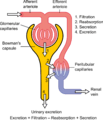Glomerular filtration rate facts for kids
The Glomerular Filtration Rate (GFR) is a special test. Doctors and other health experts use it to check how well your kidneys are working. Think of your kidneys as amazing filters for your blood. This test measures how much liquid and waste your blood filters. It shows how much goes through tiny filters in your kidneys, called glomeruli, and then turns into urine every minute.
The GFR test checks the amount of a chemical called creatinine in your blood. Creatinine is a waste product from your muscles. How much creatinine is in your blood helps show how well your kidneys are cleaning it. For a healthy person, GFR usually stays about the same.
To do the test, a small amount of blood is taken. This blood is then sent to a lab. Normal GFR values are usually between 90 and 110 ml per minute. If the value is below 60 ml/minute, it can mean a person has a long-term kidney problem. A value below 15 ml/minute means the kidneys have stopped working.
Contents
Why Do Doctors Check Your GFR?
Measuring your GFR is very helpful for doctors. It helps them find out if someone has a kidney disease. A normal GFR is usually between 90-110 ml/min. This number might naturally go down a bit as people get older. It also goes down if someone has kidney disease.
Besides helping to find a kidney disease, the GFR test also helps doctors watch how a kidney problem is changing over time. This way, they can make sure you get the best care.
How Is the GFR Test Done?
The GFR test starts with a simple blood draw. A nurse or doctor will take blood from a vein in your arm, often near your elbow. Sometimes, they might take it from a vein on the back of your hand. You might feel a quick, sharp sting when the needle goes in.
After the blood is collected, it goes to a medical laboratory. There, a special technician calculates the GFR. It's possible to get a very exact GFR value. However, most of the time, doctors use an estimated GFR, called an eGFR. This estimate is based on the amount of creatinine in your blood. The calculation might also consider your gender, age, height, weight, and race.
Getting a super exact GFR needs more complex tests and special equipment. Doctors usually use the eGFR along with your symptoms and your medical history. This helps them figure out what might be going on with your kidneys. Sometimes, a final diagnosis of kidney disease might need a biopsy of the kidney. This means taking a tiny piece of kidney tissue to look at closely.
There are a few small risks with this test. These include a little bleeding where the needle went in. Sometimes, blood might collect under the skin, which is called a hematoma. You might also feel a bit faint. Very rarely, there could be a small risk of infection where the skin was pierced.
What Affects Your GFR?
Many things can affect your GFR. Your kidneys filter out waste products like nitrogen-based waste. They also manage important things like sodium (salt), water, potassium, and phosphate. Some medicines, like digoxin and gentamicin, are also filtered by your kidneys.
Other factors that influence GFR include your blood pressure. The balance of acids and bases in your body also plays a role. Your kidneys also release a chemical called erythropoietin. This chemical tells your body to make more red blood cells. Your kidneys also help activate vitamin D. They can even help make glucose (sugar) when you haven't eaten. And they help create certain hormones, like insulin. All these functions are connected to how well your kidneys filter.
Understanding Your GFR Results
If your GFR is less than 60 ml/minute for three months or longer, it usually means you have chronic kidney disease. If your GFR drops below 15 ml/minute, it means your kidneys have completely failed.
Sometimes, a GFR between 60 and 89 ml/minute doesn't mean you have chronic kidney disease. This is true unless there are other signs of kidney problems. Also, people with a lot of muscle mass, like bodybuilders, might have GFR results that look lower than normal. People with very little muscle mass, like amputees or those with muscle wasting, might have results that look higher. In these cases, the GFR might still be normal for them. Your doctor will always explain what your GFR test results mean for you.
Related Pages
Images for kids
See also
 In Spanish: Tasa de filtración glomerular para niños
In Spanish: Tasa de filtración glomerular para niños




